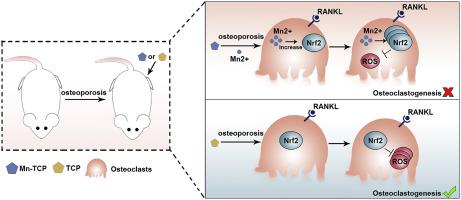Bioactive Materials ( IF 18.0 ) Pub Date : 2021-04-12 , DOI: 10.1016/j.bioactmat.2021.03.039 Jianmei Li , Cuijun Deng , Wanyuan Liang , Fei Kang , Yun Bai , Bing Ma , Chengtie Wu , Shiwu Dong

|
Osteoporosis is caused by an osteoclast activation mechanism. People suffering from osteoporosis are prone to bone defects. Increasing evidence indicates that scavenging reactive oxygen species (ROS) can inhibit receptor activator of nuclear factor κB ligand (RANKL)-induced osteoclastogenesis and suppress ovariectomy-induced osteoporosis. It is critical to develop biomaterials with antioxidant properties to modulate osteoclast activity for treating osteoporotic bone defects. Previous studies have shown that manganese (Mn) can improve bone regeneration, and Mn supplementation may treat osteoporosis. However, the effect of Mn on osteoclasts and the role of Mn in osteoporotic bone defects remain unclear. In present research, a model bioceramic, Mn-contained β-tricalcium phosphate (Mn-TCP) was prepared by introducing Mn into β-TCP. The introduction of Mn into β-TCP significantly improved the scavenging of oxygen radicals and nitrogen radicals, demonstrating that Mn-TCP bioceramics might have antioxidant properties. The in vitro and in vivo findings revealed that Mn2+ ions released from Mn-TCP bioceramics could distinctly inhibit the formation and function of osteoclasts, promote the differentiation of osteoblasts, and accelerate bone regeneration under osteoporotic conditions in vivo. Mechanistically, Mn-TCP bioceramics inhibited osteoclastogenesis and promoted the regeneration of osteoporotic bone defects by scavenging ROS via Nrf2 activation. These results suggest that Mn-containing bioceramics with osteoconductivity, ROS scavenging and bone resorption inhibition abilities may be an ideal biomaterial for the treatment of osteoporotic bone defect.
中文翻译:

含锰生物陶瓷通过清除ROS抑制破骨细胞生成并促进骨质疏松性骨再生
骨质疏松症是由破骨细胞激活机制引起的。患有骨质疏松症的人容易出现骨骼缺陷。越来越多的证据表明,清除活性氧(ROS)可以抑制核因子κB配体(RANKL)诱导的破骨细胞形成的受体激活剂,并抑制卵巢切除术引起的骨质疏松症。开发具有抗氧化特性的生物材料以调节破骨细胞活性以治疗骨质疏松性骨缺损至关重要。先前的研究表明,锰(Mn)可以改善骨骼再生,补充Mn可以治疗骨质疏松症。然而,锰对破骨细胞的作用以及锰在骨质疏松性骨缺损中的作用仍不清楚。在本研究中,通过将Mn引入到β-TCP中来制备模型生物陶瓷,含Mn的β-磷酸三钙(Mn-TCP)。将Mn引入β-TCP中可显着改善对氧自由基和氮自由基的清除,表明Mn-TCP生物陶瓷可能具有抗氧化性能。这体内和体外研究发现,在体内骨质疏松条件下,从Mn-TCP生物陶瓷中释放的Mn 2+离子可以明显抑制破骨细胞的形成和功能,促进成骨细胞的分化,并促进骨再生。从机理上讲,Mn-TCP生物陶瓷通过通过Nrf2激活清除ROS来抑制破骨细胞生成并促进骨质疏松性骨缺损的再生。这些结果表明,具有骨传导性,ROS清除和骨吸收抑制能力的含锰生物陶瓷可能是治疗骨质疏松性骨缺损的理想生物材料。











































 京公网安备 11010802027423号
京公网安备 11010802027423号